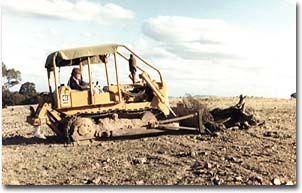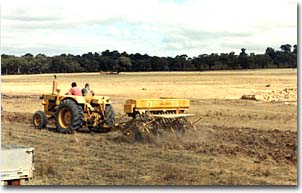Reclamation of Tunnelled Land
Tunnel Erosion Home | Distribution of Tunnel Erosion | Tunnel Initiation & Development | Conclusions | References
Early Attempts to Reclaim Tunnel-eroded Areas in Victoria | Current Reclamation Techniques
Boucher (1990) has reviewed the various methods used in attempts to reclaim tunnel-eroded land in Victoria, and noted that tunnel erosion is a natural form of drainage which is unlikely to be eliminated entirely. He also discussed the recurrence of tunnel erosion following attempts at reclamation in Australia. Essentially, the variety of initiation mechanisms at different sites coupled with a lack of knowledge regarding how tunnels subsequently develop makes the formulation of an appropriate way to approach this environmental problem somewhat difficult. A combination of mechanical, vegetative and chemical measures has been proposed by Ford et al. (1993) and Boucher (1995), but a great deal of research is still required to achieve a successful and cost-effective programme (Boucher, 2001). It is important to control the population of rabbits, the burrowing activities of which, in some circumstances, can create localised access for runoff to enter the subsoil producing tunnels (e.g. Pickard, 1999). They also tend to eat the newly-sown grasses.
Early Attempts to Reclaim Tunnel-eroded Areas in Victoria
In the 1940s and 1950s, hillslopes which were severely eroded by water and on which the re-establishment of vegetation was slow, were divided into a series of shorter segments by the use of contour furrows in order to reduce overland flow and erosion of the soil surface. Downes (1946) noted that, providing tunnels were broken and blocked, these furrows should not only reduce localised concentrations of surface runoff which were associated with tunnel initiation, but also make infiltration more even over the slope at an initially increased rate until the sown vegetation could become established and use-up the rainfall and runoff. Improved productive capacity and limited development of sheet erosion were early benefits of this approach (Anon., n.d.a.).
However, tunnel erosion was exacerbated by the use of contour furrows at many sites (Boucher, 1990), especially when pasture improvement was inadequate. For example, if shallow-rooted grasses were sown they may not be able to use-up the additional throughflow, thus permitting subsurface seepage in greater volumes than intended. Depending on rainfall event characteristics and the state of vegetative cover, it remained possible for overland flow to occur between furrow segments. Runoff was able to accumulate in and move along the furrow and scour the often dispersive subsoil, with enhanced wetting of the material being made by the increased role of throughflow. The ponding of water alone could be sufficient to cause dispersion of susceptible clays.
A furrow may be breached by soil cracks (Monteith, 1954) related to in situ soil characteristics, or to factors such as the removal of rocks and old root lines uncovered or further exposed during excavation. Minor deviations from the contour during construction such as caused by visual judgement rather than a the use of a level or diversion of the tractor from the contour could create depressions in which runoff may accumulate. Colclough's (1965) work in Tasmania indicated that tunnel erosion could not be controlled by pasture furrows and contour banks. Owing to the above-mentioned and others discussed by Boucher (1990), contour furrows have generally not been used as a soil conservation technique in Victoria since the early 1960s (D. Elvery, pers. comm.).
Current Reclamation Techniques
Generally speaking, a combination of mechanical, chemical and vegetative measures is designed to destroy existing tunnels, limit overland flow, promote relatively even infiltration and increase the polyvalent cation concentration on the clay complex, especially in dispersive subsoils.
|  Clearing tree stumps as part of reclaming tunnelled land near Redcastle.  Chisel seeding near Bailliestone. Tunnel erosion is evident at the center right hand side of the photograph. Photograph: Stuart Boucher |
Lime can produce an increase in soil pH, calcium levels and the availability of molybdenum as well as lowering the concentrations of aluminium and manganese and assisting in the nodulation of legumes (Cumming and Elliott, 1991). The levels of electrolyte will be reduced by leaching, such as associated with rainfall, so that small supplementary amounts of gypsum together with fertilizers to ensure pasture growth and the required level of water usage will need to be applied (Shanmuganathan and Oades, 1983; Boucher, 1995).
The aims of revegetating a tunnelled area include improving soil fertility and increasing the evenness of infiltration (Colclough, 1967), and imparting a degree of stability to the soil structure. A vigorous vegetative cover can limit the drying effects on the soil during summer and prolong the benefits of microbial activity on aggregate stability (Tisdall et al., 1978).
Vegetative measures include the planting of tree species with Black wattle (Acacia decurrens), Grey box (Eucalyptus hemiphloia), Yellow gum (E. leucoxylon), Red box (E. polyanthemos) and Iron bark (E. sideroxylon) having performed similarly well on severely tunnelled soils in Victoria (Newman and Phillips, 1957). Zallar (1980) suggested the use of Grey Box, Red Ironbark, Yellow gum, and Golden Western Wreath (A. saligna) and Sallow wattles (A. longifolia). Green mallee (E. viridis), Brown mallet (E. astringens) and Sugar gum (E. cladocalyx) have become the best-established varieties in the Parwan Valley (R. Hartland, pers. comm.).
The composition of annual and perennial seedlings to be sown is largely a function of climatic characteristics and soil properties. Working in the Riverina district of NSW, Floyd (1974) advocated the use of perennial ryegrass (Lolium perenne), Woogenellup subterranean clover (Trifolium subterraneum) and commercial phalaris (Phalaris tuberosa).
Downes (1956) noted that the primary function of lime application was to improve the environment for the multiplication of Rhizobium species in the subterranean clover plant roots to form nodules. Tisdall and Oades (1979) found that dominantly Vesicular Arbuscular mycorrhizal fungal hyphae in the rhizosphere of perennial ryegrass increased the size of water-stable aggregates from 50-250 µm into units larger than 2 000 µm. This increase in aggregate dimensions was strongly related to the length of hyphae per gram. As opposed to young white clover, ryegrass supported a larger population of the fungi, which persisted for at least six months after the death of the plant (Tisdall and Oades, 1980a), and though not viable, bound the soil particles into stable aggregates (Tisdall and Oades, 1980b).


